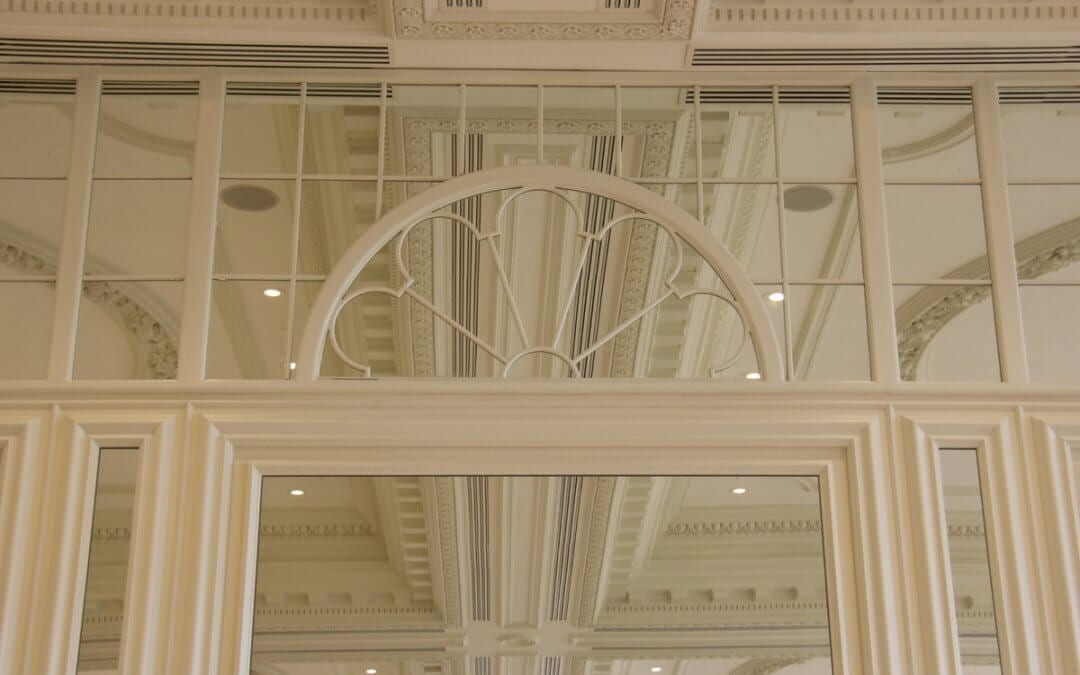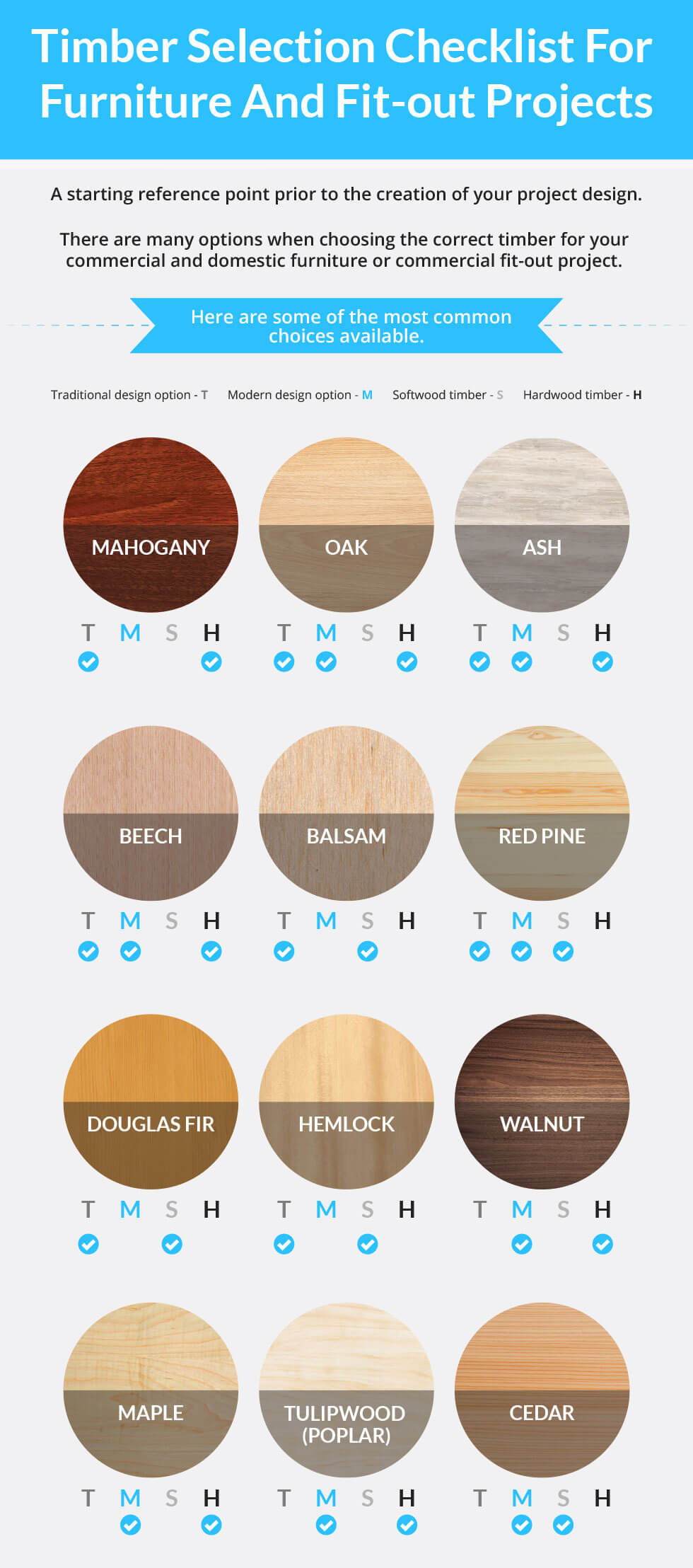TIMBER SELECTION CHECKLIST FOR FURNITURE AND FIT-OUT PROJECTS
Choosing the Correct Wood Type for Your Commercial and Domestic Furniture or Fit-out Project.
A starting reference point prior to the creation of your project design.
There are many options when choosing the correct timber for your project.
You are an experienced architect, interior designer, business owner or construction professional who is very knowledgeable in all aspects of timber material choice. However, there may be that special one-off project where it may benefit involving an experienced commercial joinery company at the concept stage of your initial plans. This could save you time and money in the long run. Here at Allstar Joinery, we have seen many situations where involving our highly experienced team at the concept and design stage has paid dividends during the project and ensured a timely completion, to specification and budget. Correct timber selection is a crucial part of this process.
Choosing the Correct Timber Colour Option
Dark or light timber?
This depends on the theme of the project and the durability of the timber required.
The amount of natural sunlight directly entering the internal space may have an impact on your choice in terms of the progressive effect the sunlight may have on the colour gradient of the wood.
There are no rules to say you cannot stain any timber however, some timbers benefit more from a stain application than others because of their natural characteristic grain.
The Benefits of Staining Timber
The majority of projects involving wood require the wood material to be stained.
The staining option chosen is an important decision. Depending on the timber you may be limited in staining options. Staining creates depth and rich vibrant colours which in turn can enhance grain contours perhaps less visible in its natural form.
You have to consider staining particular timbers in order to limit distortion caused by UV light.
The Main Benefits of Wood Timber Staining are as Follows:
- Wide range of colour matching to suit existing furniture
- Minimises UV distortion to the timber
- Can bring out depth and the richness of the grain
Traditional or Modern Timber Options for Bespoke Joinery Projects
H – Hardwood S – Softwood
Main Traditional Project Timber Options:
- Mahogany (H)
- Oak (H)
- Ash (H)
- Beech (H)
- Red Pine (S)
- Douglas Fir (S)
Main Modern Project Timber Options:
- Walnut (H)
- Oak (H)
- Ash (H)
- Beech (H)
- Maple (H)
- Tulipwood also known as Poplar (H)
- Cedar (S)
- Red Pine (S)
Whilst we have not included balsam timber or hemlock timber in the dropdown list below, due to these wood types not being in common use, we have included these timbers in the infographic for your reference.
Mahogany Timber - Traditional hardwood timber option
Benefits
The characteristics of Mahogany are rich in colour and grain.
Non Benefits
There are no major downsides to using mahogany.
Colour options
Straight off the tree in its natural form this wood is red in colour.
Mahogany can only be dark brown or dark red.
Project options
Mahogany timber can be used for the following projects:
- Wall panelling
- Windows
- Doors
- Domestic furniture
- Commercial furniture
Oak Timber - Traditional and modern hardwood timber option
Benefits
One of the strongest timbers on the market. Oak is extremely durable.
An attractive characteristic wood type. Naturally light in colour. Oak is extremely versatile in terms of colour matching and staining
Non Benefits
As with most timbers you can have issues related to sap* content. Out of a cubic metre of oak you may have a probability 5-10% chance of sap wood.
Colour options
Oak timber is naturally light in colour and is easily stained as mentioned above.
Project options
Oak timber is predominantly used for:
- Bespoke furniture
- Fixtures and fittings
- External and internal doors
- Many other options.
Ash Timber - Traditional and modern hardwood timber option
Benefits
It is very similar to oak in terms of its grain. The ash timber is lighter in colour.
It can have a fiery and quite prominent grain which some find pleasing to the eye and others less so.
Ash timber has the same durability as oak. It is one of the strongest timbers on the market.
This is a good timber for surface preparation and finishing.
Non Benefits
There are no significant issues related to this wood type due to its similarity to oak.
Colour options
An attractive characteristic wood type. Naturally light in colour and extremely versatile in terms of colour matching and staining.
Project options
The material whilst not commonly used these days can be used predominantly for:
- Bespoke furniture
- Fixtures and fittings
- External and internal doors
- Many other options.
Beech Timber - Traditional and modern hardwood timber option
Benefits
One of the strongest timbers on the market.
Beech wood is extremely durable.
A tight grain with no open pores, adding to its durability.
Non Benefits
No major non benefits. It is a very heavy timber to lift.
Colour options
Beech timber has a small speckled grain which means there is no real benefit to staining it.
This is the most popular type of furniture grade timber used within public house, hotel and restaurant sectors.
Project options
Due to beech timber’s durability and strength it is used in projects where wear and tear could be an issue.
Beech timber can be used for the following projects:
- Bar chairs
- Bar tables
- Public house tables and chairs
- Restaurant tables
- Café tables
- School desks
- Health sector furniture
- Bespoke domestic furniture
- Bespoke commercial furniture
Red Pine Timber - Traditional and modern softwood timber option
Benefits
This is not a scarce timber and is readily available.
Competitively priced and an affordable timber option for most projects.
This wood is easy to work with therefore saving on time and wastage.
Non Benefits
Contains numerous knots. Contains sap*. Prone to bowing.
Colour options
This is the most popular type of furniture grade timber because of the spectrum of colour staining choices available.
Project options
This is the first choice for internal commercial construction.
Red pine can be used for the following projects:
- Door frames
- Partition wall frames
- Bespoke domestic furniture
- Bespoke commercial furniture`
Douglas Fir Timber - Traditional softwood timber option
Benefits
Very similar wood type to pitched pine with all its benefits.
Douglas fir is readily available. Pitched pine is not readily available.
A popular timber as it has vibrant grain colours which are easy on the eye.
Non Benefits
Sanding and preparation work are more labour and time intensive than other timbers.
Colour options
This is one of the most popular types of furniture grade timbers because of the spectrum of colour staining choices available.
Project options
This can be a good option for traditional interior refurbishments within older buildings and traditional interior fit-outs such as hotels, guest houses, public houses, bars, restaurants and retail outlets.
Douglas fir timber can be used for the following projects
- Staircases
- Stair fittings
- Architraves
- Handrails
Walnut Timber - Modern hardwood timber option
Benefits
Prime grade walnut has a rich natural brown appearance.
Non Benefits
Walnut contains sap*, this is mainly due to short supply and the demand to be harvested too quickly.
When the end product is exposed to sunlight it will change colour over time becoming a lighter shade of brown and more golden in colour. Staining is advised to prevent UV distortion of the wood grain.
Colour options
This is another one of the most popular types of furniture grade timbers because of the spectrum of colour staining choices available.
Project options
This can be a good option for traditional interior refurbishments within older buildings and traditional interior fit-outs such as hotels, guest houses, public houses, bars, restaurants and retail outlets.
Walnut timber can be used for the following projects
- Staircases
- Stair fittings
- Architraves
- Handrails
Maple Timber - Modern hardwood timber option
Benefits
This is an excellent wood to work with on many commercial furniture and commercial fit-out projects.
Due to its durability, it sands very well and the grain is so tight it polishes to a near mirror effect.
Non Benefits
It is generally looked upon as a bland timber in terms of character as it has a very uniformed appearance.
Colour options
There is little or no grain detail to maple which means there is almost no benefit in staining it. Few people choose to stain maple because of the lack of variation you would achieve.
Project options
This is a modern timber more commonly used for the following projects:
- Staircases
- Stair fittings
- Architraves
- Handrails
- Furniture
- Wall cladding
- Doors and screens
Tulipwood Timber. Known in the trade as poplar - Modern hardwood option
Benefits
An excellent timber to profile, mould, apply to paint finish. It also sands easily and machines to an excellent standard. It rarely tears or splits.
Non Benefits
It cannot be seen in its natural form as it is green in appearance, off-white and sporadic sections of black running through the unfinished grain.
Colour options
This is an excellent type of furniture grade timber because of the spectrum of colour staining choices available.
Project options
This can be a good option for traditional interior refurbishments within older buildings and traditional interior fit-outs such as hotels, guest houses, public houses, bars, restaurants and retail outlets.
Tulipwood timber also known as poplar can be used for the following projects:
- All aspects of linear profiles which would then need pointed
- Running architraves
- Staircases
- Stair fittings
- Architraves
- Handrails
Cedar Timber - Modern softwood timber option
Benefits
Probably the most waterproof timber in its natural form.
Non Benefits
Cedar is not durable and is an extremely soft timber. It requires a light touch when being used and marks very easily.
Colour options
There is no grain detail, therefore, it is mainly given a paint finish or water based exterior finish for weather protection.
Project options
This can be a good option for external commercial joinery projects. Cedar timber can be used for the projects listed below and many more:
- External cladding
- Garden sheds
- External marine bulkheads
*Sap is where the timber has been starved of its nutrients as in water and oxygen, which results in the timber not fully forming in colour, meaning there would be no visible grain.
Please always take into consideration all wood timber types can be prone to bowing.
The timbers listed can be used for the projects highlighted. The choice of timber and staining option chosen is, of course, subject to your particular project specification, therefore this blog is purely a guide.
Here at Allstar Joinery we understand the importance of meeting the professional standards expected by architects, interior designers, business owners and construction professionals.
Allstar Joinery based in Cumbernauld, Glasgow, are main and principal all trades fit-out contractors as well as project managers.
We undertake commercial joinery and shopfitting projects from conception to completion as well as the manufacture of bespoke furniture, both domestic and commercial.
View our latest success stories
We strive to achieve excellence in all aspects of construction and joinery manufacturing through integrity and innovation, delivering projects which we can all be proud of and which contribute to building long term and mutually beneficial working relationships.
We’re here to help, investing in projects to collectively exceed expectations.
We cover all main sectors such as restaurants, hotels, bars, education, health, office, retail, student accommodation and commercial, domestic or public sector projects.
If you would like to discuss a new project, talk about a current one or find out more about our work and would like to speak to Robert Hoey, Managing Director of Allstar Joinery Ltd, please call 0800 270 7779 or email robert.hoey@allstarjoinery.com.
Blog author
Robert Hoey,
Managing Director,
Allstar Joinery Ltd.
Robert Hoey, Allstar Joinery Ltd. Copyright © 2017



